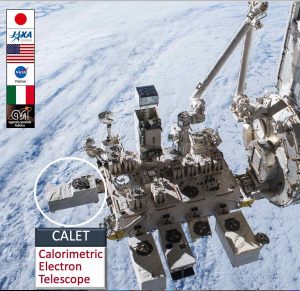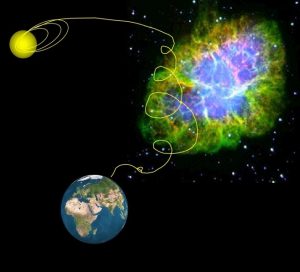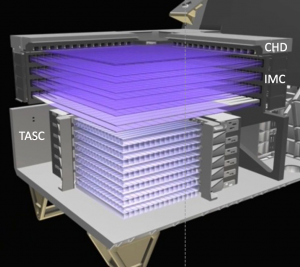A space project with the participation of the Department of Physical Sciences, Earth and Environment at the University of Siena
 CALET (CALorimetric Electron Telescope) is a sophisticated experimental apparatus, about the size of a car, in operation on the International Space Station (ISS) since 2015, where it records the passage of very energetic particles and photons coming from deep space.
CALET (CALorimetric Electron Telescope) is a sophisticated experimental apparatus, about the size of a car, in operation on the International Space Station (ISS) since 2015, where it records the passage of very energetic particles and photons coming from deep space.
Built by an international collaboration (Japan, Italy, United States) with a strong component of italian scientists from the universities of Firenze, Padova, Pisa, Siena, and IFAC-CNR, CALET is a space mission lead by the Japan Aerospace Exploration Agency (JAXA) with the participation of the Italian Space Agency (ASI) and NASA.
The University of Siena is leading the Italian participation in the mission funded by the Italian Space Agency.
Launched from the Tanegashima Space Center with the Japanese rocket H2-B and delivered to the ISS by the Orbital Transfer Module HTV-5 on August 2015, it became the second high energy experiment operating on the ISS after the deployment of the magnetic spectrometer AMS-02 in 2011.
On a Low Earth Orbit at 400 Km of altitude, CALET is carrying out a rich science program, hunting rare energetic particles (cosmic-rays) from space before they hit the atmosphere. Its most ambitious science goals include the identification of the astrophysical sources capable of accelerating electrons and charged cosmic nuclei at energies far greater than those attainable at the most powerful accelerators on Earth.

Professor Pier Simone Marrocchesi, director of the Department of Physical Sciences, Earth and Environment at the University of Siena and Italian Principal Investigator (PI) of CALET, tells us about the CALET mission in the framework of a new branch of Experimental Physics, recently born from the “marriage” of Astrophysics and Elementary Particle Physics.
What are Cosmic Rays and why it is important to study them? Cosmic Rays (CR) are charged particles accelerated by violent astrophysical events, including Super Novae explosions. They consist mostly of protons, much less of electrons, positrons, and fully ionized nuclei spanning the Table of Elements from hydrogen to iron, nickel, and beyond. They propagate in the interstellar medium and eventually reach the Earth, where they can collide with the atmosphere creating huge showers of secondary particles. Until the advent of the first particle accelerators in the 1950s, the study of CR produced the first fundamental discoveries of sub-atomic particles. Today, the main focus of this branch of Astroparticle Physics is on the production and on the interactions with matter of CR that are too energetic to be produced at the most powerful particle accelerators, as LHC at CERN.

What are the applications and practical advantages of this research? It is often heard that research should be more oriented toward immediate applications, rather than deepening the theoretical foundations of knowledge. Let me give you an example which has nothing to do with physics. When a pandemic broke out recently, there were many who took for granted the development of a vaccine in a very short time, neglecting to reflect on the fact that this was only made possible by years of study and experimentation that provided the basis for it. In our case, we deal with the understanding of the physical phenomena behind the creation very high energy states. In our energy hungry civilization this knowledge can turn out to be very useful, as well as the development of the innovative technologies that makes these experiments possible.
What are the main findings of CALET? On a vantage position on the ISS, we can capture galactic CR before they are destroyed by the atmosphere and therefore measure their energy spectra. The principal science goal of CALET is to identify the site(s) where electrons+positrons are accelerated. As these light particles rapidly lose energy by radiative losses, they are expected to originate from one or more acceleration sources located at a relatively short distance from Earth (within a few hundred light-years). The shape of the spectrum and the anisotropy in their arrival direction encode critical information on their source(s) and on possible signatures of Dark Matter. To date, CALET has contributed important and unexpected results, including the observation of a significant flux reduction of electrons at the energy of 1 TeV (i.e., 1 trillion electron-volt) and of a gradual increase of the proton flux above a few hundred GeV (spectral hardening), followed by a sharp reduction around 10 TeV (spectral softening). A similar trend has also been observed for helium nuclei. CALET has extended the energy frontier of direct measurements of light nuclei B, C and O, as well as heavier nuclei as Fe. It has delivered the first measurement of Ni spectrum at high energy and the relative abundances of trans-iron nuclei up to Zirconium (atomic number Z=40).

How can CALET reach such large energies? CALET is a powerful hunter of cosmic rays. It was designed to extend the energy reach of present space-borne magnetic spectrometers (limited by their maximum rigidity of a few TV). It can measure electrons up to ~20 TeV and nuclei up to ~1000 TeV. CALET can reach those ambitious goals thanks to a long observation time on the ISS and to an advanced imaging calorimeter where cosmic particles release energy by generating showers that can be visualized by the instrument. This allows for a measurement of their kinetic energy with a large proton-electron discrimination power. The identity of the CR particle is established by dedicated detectors, located on top of the instrument, that measure its electric charge.
What are the perspectives for CALET? CALET original mission lifetime of 5 years has already been extended and data taking on the ISS is likely to continue till the end of ISS operations (in 2030, according to present plans). The analysis of the data will continue after the end of the mission for at least 2 years.

Further information on CALET can be found on the Italian site of the collaboration and links therein: https://galileo.dsfta.unisi.it

